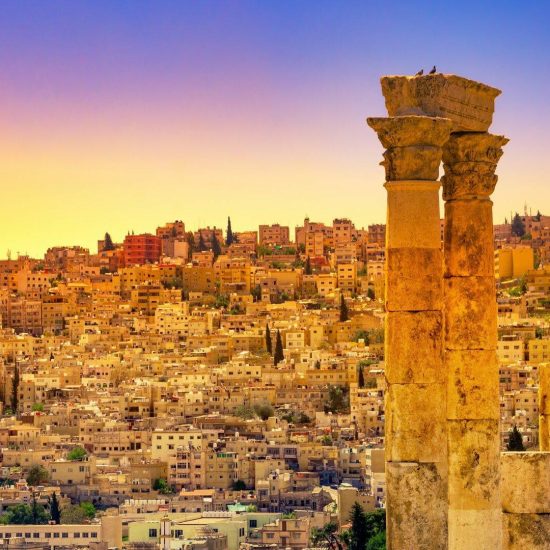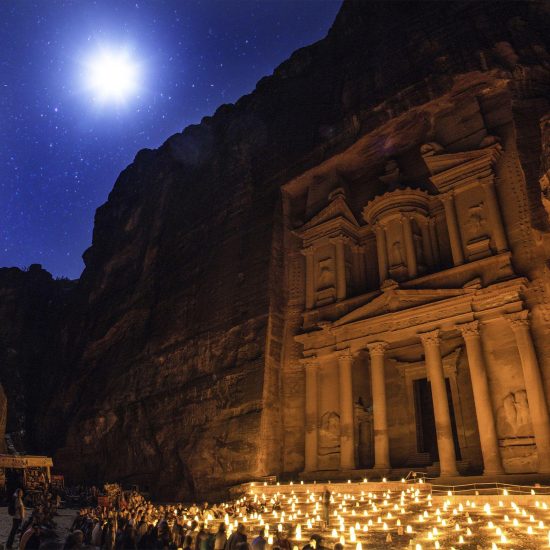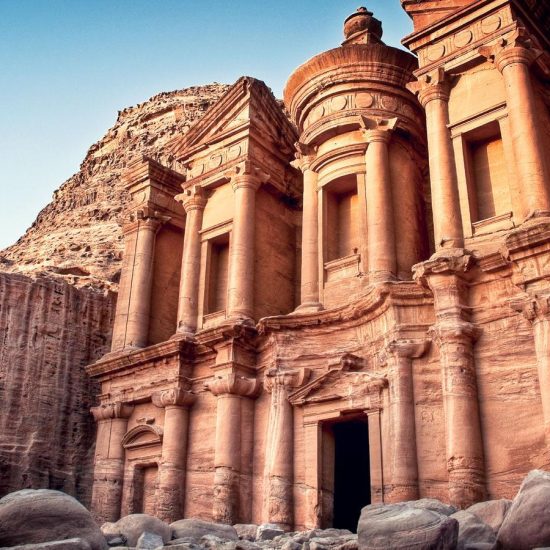Israel & Jordan – Explore Highlights
₹325000 per person
Israel, officially the State of Israel, is a country in West Asia. It is bordered by Lebanon to the north, by Syria to the northeast, by Jordan to the east, by the Red Sea to the south, by Egypt to the southwest, by the Mediterranean Sea to the west, and by the Palestinian territories – the West Bank along the east and the Gaza Strip along the southwest. Tel Aviv is the economic and technological center of the country, while its seat of government is in its proclaimed capital of Jerusalem, although Israeli sovereignty over East Jerusalem is unrecognized internationally.
Israel is located in the Levant area of the Fertile Crescent region. The country is at the eastern end of the Mediterranean Sea, bounded by Lebanon to the north, Syria to the northeast, Jordan and the West Bank to the east, and Egypt and the Gaza Strip to the southwest.
Despite its small size, Israel is home to a variety of geographic features, from the Negev desert in the south to the inland fertile Jezreel Valley, mountain ranges of the Galilee, Carmel and toward the Golan in the north. The Israeli coastal plain on the shores of the Mediterranean is home to most of the nation’s population. East of the central highlands lies the Jordan Rift Valley, which forms a small part of the 6,500-kilometer (4,039 mi) Great Rift Valley. The Jordan River runs along the Jordan Rift Valley, from Mount Hermon through the Hulah Valley and the Sea of Galilee to the Dead Sea, the lowest point on the surface of the Earth. Further south is the Arabah, ending with the Gulf of Eilat, part of the Red Sea. Makhtesh, or “erosion cirques” are unique to the Negev and the Sinai Peninsula, the largest being the Makhtesh Ramon at 38 km in length. A report on the environmental status of the Mediterranean Basin states that Israel has the largest number of plant species per square meter of all the countries in the basin. Israel contains four terrestrial ecoregions: Eastern Mediterranean conifer-sclerophyllous-broadleaf forests, Southern Anatolian montane conifer and deciduous forests, Arabian Desert, and Mesopotamian shrub desert. It had a 2019 Forest Landscape Integrity Index mean score of 4.14/10, ranking it 135th globally out of 172 countries.
Jordan, officially the Hashemite Kingdom of Jordan, is a country in West Asia. It is situated at the crossroads of Asia, Africa, and Europe, within the Levant region, on the East Bank of the Jordan River. Jordan is bordered by Saudi Arabia to the south and east, Iraq to the northeast, Syria to the north, and the Palestinian West Bank and Israel to the west. The Dead Sea is located along its western border and the country has a 26 km (16 mi) coastline in its southwest on the Gulf of Aqaba’s Red Sea, which separates Jordan from Egypt. Amman is Jordan’s capital and largest city, as well as its economic, political, and cultural center.
Jordan sits strategically at the crossroads of the continents of Asia, Africa and Europe, in the Levant area of the Fertile Crescent, a cradle of civilization. It is 89,341 square kilometers (34,495 square miles) large, and 400 kilometers (250 miles) long between its northernmost and southernmost points; Umm Qais and Aqaba respectively. The kingdom lies between 29° and 34° N, and 34° and 40° E. It is bordered by Saudi Arabia to the south and the east, Iraq to the north-east, Syria to the north, and Israel and Palestine (West Bank) to the west.
The east is an arid plateau irrigated by oases and seasonal water streams. Major cities are overwhelmingly located on the north-western part of the kingdom due to its fertile soils and relatively abundant rainfall. These include Irbid, Jerash and Zarqa in the northwest, the capital Amman and As-Salt in the central west, and Madaba, Al-Karak and Aqaba in the southwest. Major towns in the eastern part of the country are the oasis towns of Azraq and Ruwaished.
In the west, a highland area of arable land and Mediterranean evergreen forestry drops suddenly into the Jordan Rift Valley. The rift valley contains the Jordan River and the Dead Sea, which separates Jordan from Israel. Jordan has a 26 kilometers (16 miles) shoreline on the Gulf of Aqaba in the Red Sea but is otherwise landlocked. The Yarmouk River, an eastern tributary of the Jordan, forms part of the boundary between Jordan and Syria (including the occupied Golan Heights) to the north. The other boundaries are formed by several international and local agreements and do not follow well-defined natural features. The highest point is Jabal Umm al Dami, at 1,854 m (6,083 feet) above sea level, while the lowest is the Dead Sea −420 meters (−1,378 feet), the lowest land point on earth.
The Dead Sea, which is located along Jordan’s western border, is the lowest point on earth and a natural resort that has attracted visitors from across the region for thousands of years.
Jordan has a diverse range of habitats, ecosystems and biota due to its varied landscapes and environments. The Royal Society for the Conservation of Nature was set up in 1966 to protect and manage Jordan’s natural resources. Nature reserves in Jordan include the Dana Biosphere Reserve, the Azraq Wetland Reserve, the Shaumari Wildlife Reserve and the Mujib Nature Reserve.
-
Tour Duration
10 Nights / 11 Days -
Best Season
March to April; September to November -
Cities Covered
Tel Aviv, Galilee, Jerusalem, Amman, Petra -
Tour Category
TVS Luxury
Day 01 - Arrival - Tel Aviv
Day 02 - Caesarea / Muhraka / Megiddo / Acre
Day 03 - Tiberias / Capernaum / Banias
Day 04 - Drive Cana / Nazareth / Beit
Day 05 - Jerusalem (Old City)
Day 06 - Jerusalem (New City) / Bethlehem
Day 07 - Qumran / Masada / Dead Sea
Day 08 - Jerusalem / Sheikh Hussein Bridge / Jerash / Amman
Day 09 - Amman / Petra
Day 10 - Petra / Madaba / Mount Nebo / Allenby Bridge / Tel Aviv
Day 11 - Tel Aviv / Ben Gurion Airport
Tour Location
Leave a Reply
- Sharing transfers on arrival and departure (from/to Ben Gurion Airport)
- Assistance at the airport upon arrival
- 10 nights’ accommodation on half board basis
- (Due to availability, the second night in Jordan might take place in Amman instead of Petra)
- 9 touring days as per itinerary, with English speaking guide
- Entrance fees to the sites visited as per itinerary.
- International & Domestic Airfare
- GST 5% on Final Billing
- TCS 5% or 20% as per Government Norms
- Optional Tours & Extra Transfers other than itinerary
- Tourist Visa
- Travel & Medical Insurance
- Meals other than what is mentioned - lunches, dinners, snacks, drinks, etc.
- Services of Guide unless specified.
- Entrance Fees for Monument & Museums, National Parks etc.











